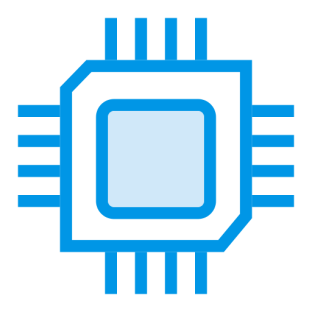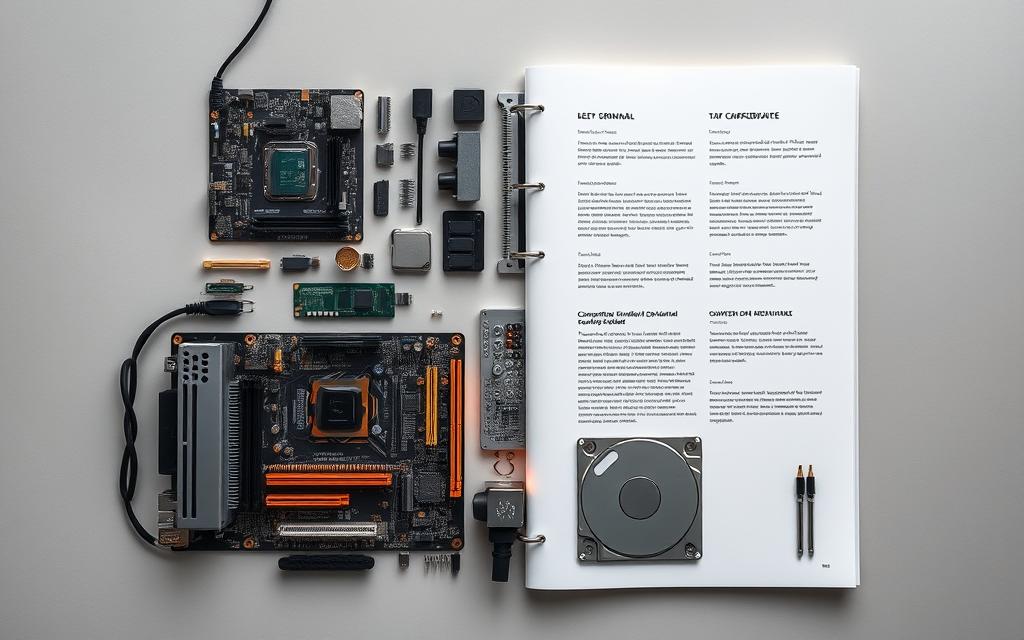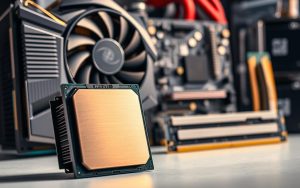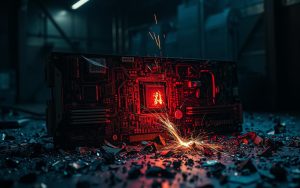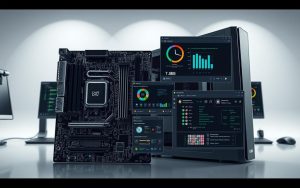Computer hardware repair is a vital skill in our digital world. About 30% of computer problems come from hardware failures. These can include RAM issues and power supply troubles.
Modern computers need careful upkeep. Many users lack proper repair tools, which can lead to more damage. However, basic know-how can fix about 10% of hardware problems.
Pro repair services often charge $50 to $150 per hour. This makes DIY computer fixes a good choice for saving money. Learning repair techniques can help avoid costly repairs and keep your computer running longer.
Regular care is key to a healthy computer. Most users don’t clean their hardware often enough. This can slow down the computer and cause overheating.
By learning basic repair skills, you can keep your computer in top shape. These skills help prevent problems and boost performance.
Understanding Basic Computer Hardware Components
Computer hardware is the backbone of any digital system. Each part plays a key role in overall performance. Knowing these essential computer components helps users fix tech issues better.
Modern computers have several key hardware elements. These parts work together to process and store information. They ensure smooth operation and top performance.
Central Processing Unit (CPU)
The CPU is the brain of the computer. It runs instructions and does calculations. Key CPU features include:
- Clock speed (measured in GHz)
- Number of cores
- Cache memory size
Memory and Storage Devices
Random Access Memory (RAM) provides quick storage for active apps. Storage devices like SSDs and HDDs keep data for the long term.
| Component | Function | Average Capacity |
|---|---|---|
| RAM | Temporary data storage | 8-32 GB |
| SSD | Fast data storage | 256 GB-2 TB |
| HDD | Long-term data storage | 1-4 TB |
Motherboard and Power Supply
The motherboard connects the CPU, RAM, and other key hardware. It’s the main communication hub for computer parts. The power supply unit gives stable electricity to all system components.
Proper understanding of computer components can significantly improve your ability to diagnose and resolve hardware issues.
Common Hardware Failure Symptoms
Spotting hardware failure signs is key to keeping your computer running smoothly. These signs can show up in different ways. They warn users about hardware problems that need quick fixing.
Hardware issues often have unique warning signs. Knowing these signs helps pinpoint what’s wrong with your computer. Most problems have clear indicators that make diagnosis easier.
- Unexpected system freezes
- Unusual noises from internal components
- Persistent blue screen errors
- Slow system performance
- Intermittent boot failures
Loud clicking or grinding noises often mean trouble with cooling fans or hard drives. Approximately 70% of computer issues originate from hardware problems. Catching these issues early is vital.
| Symptom | Potential Cause | Recommended Action |
|---|---|---|
| System Freezing | Insufficient Memory | Check RAM, Close Unnecessary Applications |
| Blue Screen Errors | Hardware Compatibility | Update Drivers, Run Diagnostics |
| Loud Mechanical Noises | Hard Drive Failure | Backup Data, Consider Replacement |
Regular upkeep can cut hardware failure risks by up to 40%. Keep an eye on your system. Act fast when you spot issues to avoid major breakdowns.
Essential Tools and Safety Precautions for Hardware Repair
Hardware repair needs special know-how and tools. Safety is key when working with delicate electronics. Proper prep and protection are vital for success.
The right tools and safety rules are crucial. Technicians need proper gear and knowledge to reduce risks during repairs.
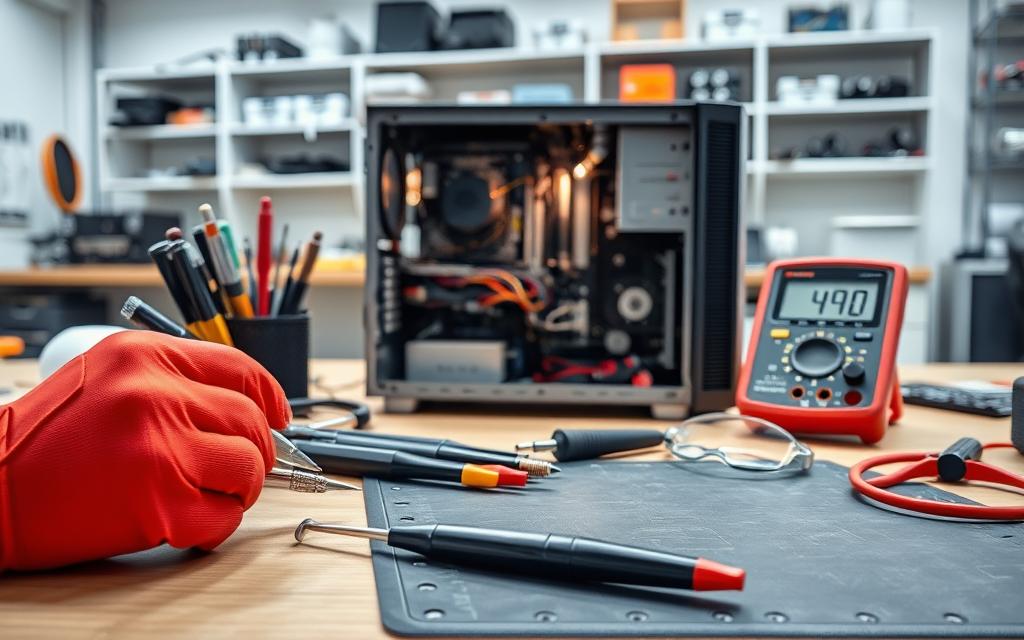
Recommended Repair Tools
- Anti-static wrist strap
- Precision screwdriver set
- Compressed air duster
- Multimeter
- Thermal paste applicator
- Cable organizers
Safety Guidelines and Precautions
Strict safety measures are vital when handling computer parts. Static can damage sensitive electronics. Grounding techniques are essential to prevent this.
| Safety Measure | Purpose | Risk Reduction |
|---|---|---|
| Anti-static wrist strap | Prevent static discharge | Up to 90% reduction in component damage |
| Ground connection | Neutralize electrical potential | Minimize electrical interference |
| Proper workspace setup | Ensure clean, organized environment | Reduce accidental component damage |
Workspace Setup Requirements
A good workspace is key for safe hardware repair. Technicians should keep their area clean, well-lit, and organized. This helps reduce potential risks.
- Use a non-conductive work surface
- Ensure adequate lighting
- Maintain a clutter-free workspace
- Keep liquids and food away from repair area
- Use surge protectors for equipment
Pro tip: Always back up critical data before attempting any hardware repairs to prevent potential information loss.
How to Repair Computer Hardware: Step-by-Step Approach
Fixing computer hardware requires a systematic approach. Most issues can be solved by following a step-by-step guide. This method breaks down complex problems into manageable tasks.
Start your repair process with these key steps:
- Perform a visual inspection of all hardware connections
- Check power cables and ensure secure connections
- Listen for unusual sounds indicating potential hardware failures
- Verify system temperature and cooling functionality
Key diagnostic techniques help spot hardware problems quickly. Approximately 60% of computer issues stem from loose connections or simple power-related problems. Look out for:
- Unusual system noises (clicking or grinding)
- Unexpected performance drops
- Intermittent system freezes
- Unexpected error messages
A simple system reboot can fix 90% of computer freezes. For tougher issues, try these advanced steps:
- Run comprehensive system diagnostic tools
- Test individual hardware components
- Check for driver conflicts
- Verify BIOS settings
Professional tip: Always start with the simplest solutions before diving into complex repairs.
Knowing these repair steps will help you tackle most hardware problems. You can save money by avoiding costly professional help.
Troubleshooting Power and Boot Issues
Fixing computer power and boot problems is crucial for keeping your device running smoothly. Knowing why startup issues happen can prevent data loss and save time.
These skills help maintain your computer’s performance. They also protect your valuable information from potential loss.
When your computer has power problems, try these steps to find and fix the issue:
- Check power supply connections
- Verify electrical outlet functionality
- Listen for diagnostic beep codes
- Inspect internal hardware connections
Power Supply Problems
A bad power supply can shut down your computer completely. Sporadic problems such as spontaneous reboots are often caused by poor-quality electrical power. About 20-30% of boot issues may stem from poor electrical power quality.
“The health of your computer’s power supply determines its overall system stability.”
BIOS and CMOS Issues
BIOS setup problems can stop your system from starting. If you can still access BIOS information, your system is likely fixable.
Try carefully resetting BIOS settings. You might also need to replace the CMOS battery.
Boot Sequence Failures
Solving boot failures requires a step-by-step approach. Static electricity can cause parts to fail in up to 30% of cases.
Always unplug external cables when diagnosing boot issues. Use anti-static precautions to protect your computer’s components.
- Verify boot device order
- Check hard drive connections
- Test RAM modules
- Examine startup error messages
Advanced Hardware Diagnostics and Solutions
Advanced hardware troubleshooting needs a smart approach to solve complex computer issues. Pros and tech fans use high-tech tools to find system problems quickly.
Diagnostic strategies use many methods to spot hardware issues. These include stress testing, analyzing performance logs, and reading error codes.
Advanced tools are key in hardware troubleshooting. They help experts find and fix problems faster.
- Stress testing critical components
- Analyzing system performance logs
- Interpreting error codes
- Running comprehensive diagnostic software
Here are some important diagnostic tools:
| Diagnostic Tool | Primary Function | Detection Rate |
|---|---|---|
| SMART Technology | Hard Drive Health Monitoring | 90% Accuracy |
| Prime95 | CPU Stress Testing | 25% System Instability Detection |
| Digital Multimeter | Power Supply Diagnostics | 10-15% Failure Identification |
Warning signs of potential hardware failures include strange noises, unexpected system crashes, and performance throttling. Diagnostic software can identify issues in 60-80% of cases when used effectively.
Regular checks can stop up to 70% of hardware problems. Knowing these methods helps users keep their computers running longer.
It also reduces surprise system failures. Take care of your computer, and it will take care of you.
Conclusion
Regular computer hardware maintenance prevents unexpected system failures. Users can reduce hardware issues by using key diagnostic techniques and proactive strategies. System checks, careful handling, and timely fixes are crucial for preventing hardware problems.
Maintaining computer hardware doesn’t require advanced technical skills. Simple practices like cleaning components and monitoring performance can extend your computer’s life. Most hardware issues come from neglect or oversights, such as unplugged parts or outdated drivers.
DIY repairs can save money, but know your limits. Some hardware problems need professional help, especially with complex laptop systems. Always prioritize safety and use proper tools when fixing hardware issues.
Successful hardware maintenance requires a proactive approach. Stay informed and perform regular diagnostics to minimize downtime. Understand your system’s unique features to maximize its performance and reliability.
Invest time in learning about your computer’s hardware. Be patient when troubleshooting issues. Remember, prevention is always cheaper than extensive repairs.
